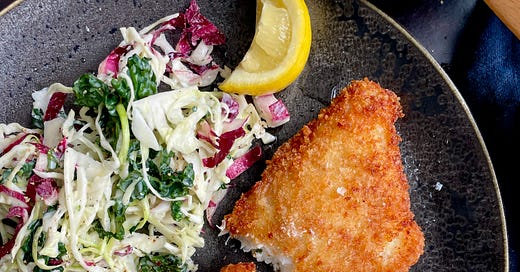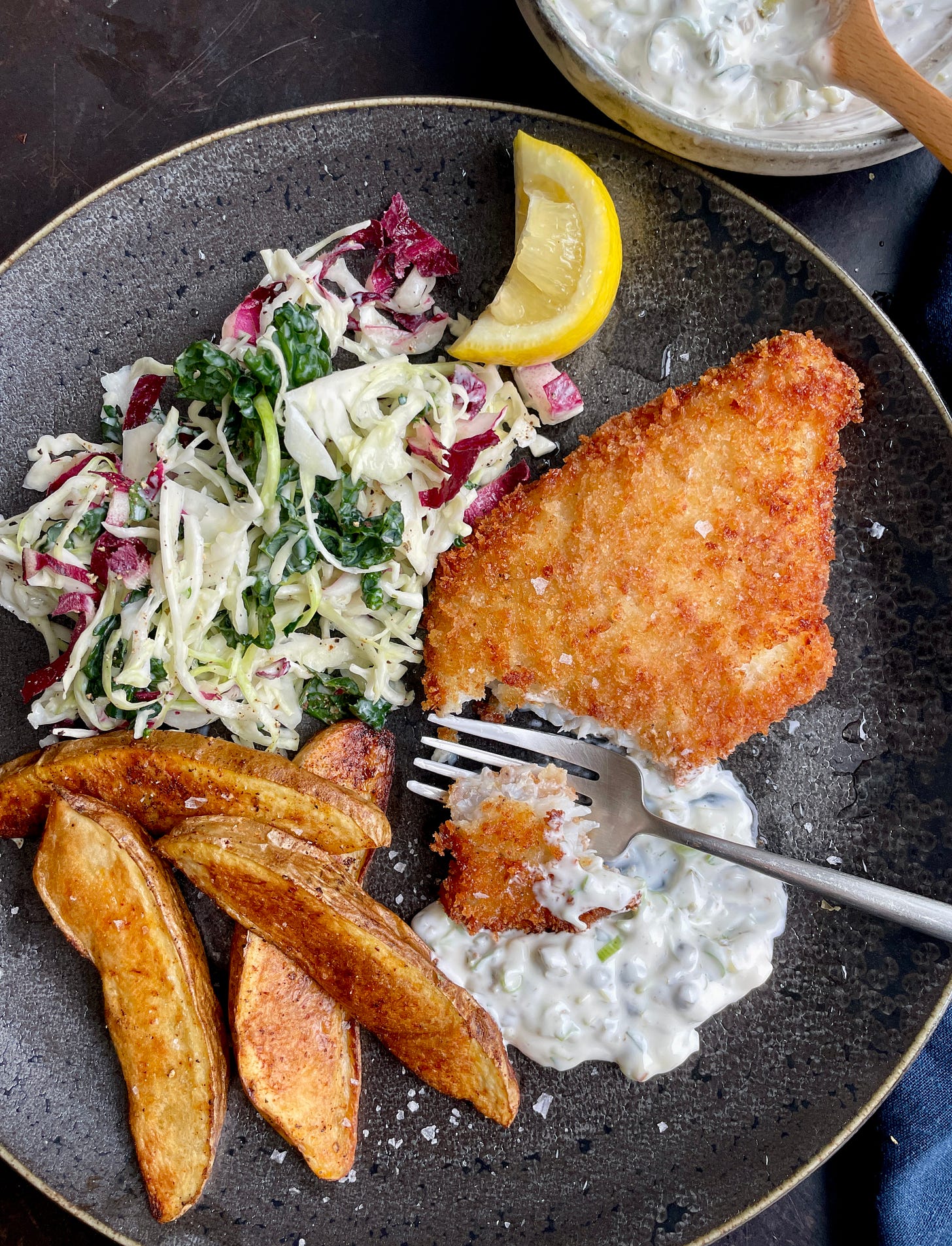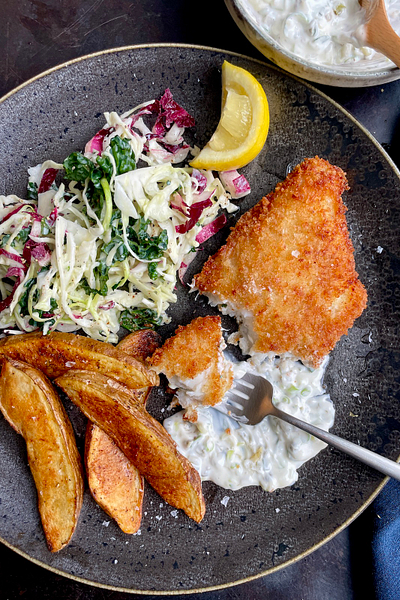Sometimes when I’m casting about for a dinner idea, I’ll ask Steve what he’s in the mood for. He always has a suggestion, which usually comes in the form of a single word (or maybe two). It might be “pork chop,” “lamb chop,” “fish,” “tofu bowl,” or “roast chicken.” That’s all I need to get inspired, and then I’m off to the races (or maybe the grocery store). We jokingly call these “one-word dinners.”
A few weeks ago, while I had Steve locked in a room nursing a case of Covid (yes, it’s still a thing), I was happily waiting on him hand and foot to avoid being exposed—and also to make his isolation a little more pleasant and delicious (his appetite was unaffected). The first few days were chicken soup and the like, but as his strength began to return, and I asked him over FaceTime what he wanted for dinner, he had just two words for me: “Crispy Fish.”
And so I complied. I was slightly reluctant at first because I usually have a “no frying at home” rule, but I decided to go for it. I ran out to get some nice fat filets of fluke. I found that larger, thicker filets were perfect for this, since the thickness ensures that the center will be moist and juicy by the time the outside gets golden and crispy. Fluke is abundant where I am, but use whatever flaky, white fish filets are available where you live.

I made it all into a typical shore dinner. I made a delicious tartar sauce, for which I had all the ingredients in my fridge: cornichons left over from New Year’s Eve fondue, the end of a jar of capers I brought from our house, a bunch of tarragon on its last legs (I’ll be happy to be back home with my herb garden soon!), and an open jar of Sir Kensington’s mayonnaise, which definitely has a taste and texture that’s closer to homemade. I made some oven fries with the Idaho potatoes I always keep on hand, and a slaw out of the various crispy veggies I found in the fridge: a few radishes, some fennel, and I can’t remember what else.
In the end, it wasn’t so bad to fry at home after all. Yes, it’s a little bit messy to clean up. But it didn’t fill the air with a fishy smell, and the fish wasn’t greasy at all—and it was SO GOOD. We both enjoyed it so much (albeit in separate rooms) that I made it again a week or so later. This time we got to eat it together.

A few tips for breading and frying at home
Use tongs to handle the fish when dipping in the egg mixture to keep your fingers dry and avoid breading them!
Use neutral oil with a high smoke point, like peanut oil.
The amount of oil will vary depending on the depth and width of your pan. A little less than ¼-inch depth of oil is good, which for my 10-inch skillet was about 12 ounces.
Save the bottle of oil if you’ve finished it. Otherwise, use a glass jar to dispose of the oil once it’s cooled.
Heat the oil slowly so it doesn’t get too hot too fast. It’s easier to control the temperature if you heat it slowly.
When you add the fish to the pan, don’t drop it in. Gently lower it into the oil away from you so that you don’t splash yourself.
Adjust the temperature frequently so it’s not too hot or too cool.
You want the fish to cook relatively quickly, but not so fast that the outside gets too dark before the inside is done.
Be very careful to flip the fish away from you to avoid splashing yourself with hot oil.
I use a fish spatula for everything, but it’s especially good for fish!
Crispy Fish with Tartar Sauce
Serves 2
I like to bread the filets and chill them while I prepare the rest of the meal. You can do this up to one day ahead of time as long as your fish is very fresh. Then I fry them at the last minute. You can easily coat more fish with this amount of breading material. Leftovers keep pretty well!
For the fish:
¾ pound fluke filets or other flaky flat fish
All-purpose flour
1 to 2 large eggs
1 cup panko breadcrumbs
Kosher salt
Freshly ground black pepper
Vegetable oil (I used peanut)
Flaky salt
For the tartar sauce:
⅓ cup mayonnaise (I used Sir Kensington’s)
2 scallions, minced
2 teaspoons chopped tarragon or parsley, optional
4 cornichons, chopped
1 tablespoon capers, rinsed and chopped
2 teaspoons lemon juice, or to taste
Cut the fish into pieces. I like to cut down the midline of the filet, and then crosswise into 4 pieces, so you have 2 thick pieces and 2 thin pieces which will cook at different rates. This will vary depending on how large your fish filets are.
Set up a 3-step breading station: flour on a dinner plate, beaten eggs in a medium shallow bowl, and panko on another dinner plate. Season the flour and eggs with salt and pepper.
Dip a piece of fish into the flour and shake off excess. Slip it into the egg mixture, and use tongs to remove it, letting excess drip off. Place on the plate with the panko, and scoop some of the panko on top, pressing and turning until it’s well-coated. Transfer to a dinner plate and repeat the process with the remaining fish. Chill until ready to fry.
Make the sauce: Combine mayonnaise, scallions, tarragon, cornichons, capers, and lemon juice. Stir to combine and chill until ready to serve.
Slowly heat about ¼ inch of oil in a straight-sided skillet over low heat. Turn up the heat to medium or medium high. When the oil shimmers, throw in a few panko crumbs. If they sizzle, add pieces of fish (I do 2 at a time in my pan). The oil should be about 275°F. Cook until deeply and evenly golden brown, 2 to 3 minutes. Gently flip (away from you), and cook the other side for 2 to 3 minutes. Transfer to a paper towel-lined plate while you fry the rest. Keep warm in a 175°F oven while you work. Repeat with remaining fish. Sprinkle with flaky salt and serve immediately.








This is so thoughtfully written. will put on menu soon.
This looks delicious. I’ll try it soon. Like you, I prefer no indoor frying, so I’ll try it in cast iron on the grill. 😋